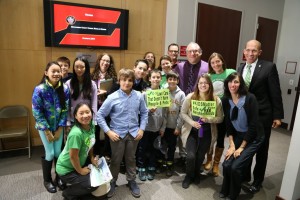07
Oct
Maryland County Bans Cosmetic Lawn Pesticides on All Land in County, One Million People Protected
(Beyond Pesticides, October 7, 2015) The largest county in the country to act to ban pesticides will forbid toxic pesticides on public and private land within its jurisdiction, based on legislation passed yesterday by a 6-3 vote. The ban, an historic public health measure, will protect one million people in a county outside Washington, DC, as it allows time for transition, training, and a public education program over the next several years. The amended bill was enacted with the support of Council President George Leventhal (the lead sponsor of the original bill), Councilmembers Marc Elrich, Tom Hucker, Nancy Navarro, Hans Riemer and Council Vice President Nancy Floreen, who voted in favor.
 Maryland is one of seven states that has not taken away (or preempted) local authority to restrict pesticides more stringently than the state. One of the cities within the county, Takoma Park, passed a similar ordinance back in 2013. The Town of Ogunquit, Maine adopted a similar ordinance by ballot initiative in November, 2014.
Maryland is one of seven states that has not taken away (or preempted) local authority to restrict pesticides more stringently than the state. One of the cities within the county, Takoma Park, passed a similar ordinance back in 2013. The Town of Ogunquit, Maine adopted a similar ordinance by ballot initiative in November, 2014.
“Today’s action is another step in the ongoing effort to make Montgomery County the healthiest, safest county in the country,” said Council President Leventhal. “Countless studies have linked pesticides to a wide range of health conditions in children and adults and, since the bill was introduced one year ago, I have received hundreds of reports from constituents of children and pets experiencing adverse effects from the application of pesticides.”
“Local government can””and should””step in a preventative way to protect the public’s health, even when there is not complete scientific certainty,” Council President Leventhal continued. “The science may never be conclusive since it involves complex chemical interactions, but the absence of incontrovertible evidence does not justify inaction. ”
At the last committee hearing before the full council on September 17, the Transportation and Environment (T&E) Committee voted 2-1 on substitute legislation, proposed by Committee Chair Roger Berliner, to remove the central portions of the bill intended to transition Montgomery County land, including public and private property, to non-toxic sustainable management practices.
The Montgomery County Parks Department has fought against the bill, suggesting that fields cannot be managed with organic practices. As a result, one of the amendments to the original bill will allow the County’s Department of Parks to continue to use pesticides on playing fields as part of an integrated pest management program and requires the department to develop a plan that would lead to maintaining fields without pesticide use by 2020. The department will conduct a pilot program in the interim period to study the impact of maintaining fields without using pesticides. Extensive testimony on alternatives has educated council members on the viability of organic practices.
There is movement across the country to adopt ordinances that stop pesticide use on public property and, where allowed, private property. Pesticides when used move off the target site through drift and runoff, exposing non-target sites and people.
Beyond Pesticides worked closely with Safe Grow Montgomery, a local coalition of individual volunteers, organizations and businesses to help educate the public on the bill. The coalition works to prevent exposure to chemicals that run-off, drift, and volatilize from their application site, causing involuntary poisoning of children and pets, polluting local water bodies such as the Chesapeake Bay, and widespread declines of honey bees and other wild pollinators.
The legislation passed yesterday is a major victory for public health and environmental protection. While the chemical lawn care industry strenuously opposed the bill, in testimony before the Council an industry spokesman said he could implement organic programs for his customers.
For more information on organic lawn care, see Beyond Pesticides lawns and landscape program page.
More details about Bill 52-14 and related amendments are available to read here.
Source: Montgomery County Press Release
All unattributed positions and opinions in this piece are those of Beyond Pesticides.










